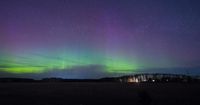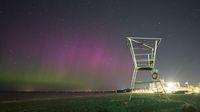On the night of Sunday, June 1, 2025, and into the early hours of Monday, June 2, a spectacular celestial event is poised to light up skies across much of the United States. Thanks to a powerful geomagnetic storm caused by a coronal mass ejection (CME) from the sun, the elusive northern lights—aurora borealis—may become visible from as many as 27 states, stretching farther south than usual and delighting skywatchers from Alaska to Alabama.
The National Oceanic and Atmospheric Administration (NOAA) has forecast a rapid increase in geomagnetic activity starting midday on June 1, continuing through June 2, with effects possibly lasting until June 3. This surge is triggered by the arrival of a CME that left the sun on May 31, carrying a massive cloud of charged particles hurtling through space toward Earth. NOAA’s Space Weather Prediction Center warns of G3 to G4 level storm conditions, classified as strong to severe, with a chance of reaching G5—extreme—levels during this period.
As NOAA explains, “By as early as midday on 01 Jun to early on 02 Jun, conditions are expected to increase rapidly with the arrival of the CME from 31 May.” While the agency expresses high confidence that the CME will reach Earth, it notes some uncertainty remains regarding the exact timing and intensity of the storm. Nonetheless, the predicted Kp index—a scale measuring geomagnetic activity—could peak at 7.67, indicating that the auroral oval will expand significantly, pushing the northern lights far beyond their usual polar confines.
Typically, auroras grace the skies near latitudes of 70 degrees north and south, but during intense geomagnetic storms, displays can be seen as far south as 25 degrees latitude. This event is no exception, with the aurora forecast to be visible from northern states such as Washington, Idaho, Montana, North Dakota, Minnesota, Wisconsin, Michigan, and Maine, as well as many others closer to the Canadian border. Remarkably, the lights may even be glimpsed as far south as northern California and Alabama, a rare treat for those regions.
The U.S. is uniquely positioned for this celestial show partly because of Earth’s tilt as it approaches the summer solstice on June 21. Longer daylight hours generally reduce the window for aurora viewing, but the geomagnetic storm’s strength could overcome this, making the northern lights visible in darker northern skies. Experts advise that the best viewing times will be between 10 p.m. and 2 a.m. local time, when geomagnetic activity typically peaks.
For those eager to catch a glimpse, NOAA recommends heading as far away from city lights as possible, ideally to locations with a dark northern horizon. Light pollution can severely diminish the visibility and brilliance of the aurora. Checking local cloud cover is also crucial, as clear skies are essential for a good show. Some areas in the Pacific Northwest and Midwest are expected to have favorable weather, while others might contend with storms.
Space weather officials have already spotted signs of this event. On Friday, May 30, a solar flare associated with the CME was detected, and by Sunday morning, National Weather Service offices from Rapid City, South Dakota, to Spokane, Washington, had captured photos of the telltale green and purple streaks lighting up the sky.
But what exactly causes these mesmerizing lights? The aurora borealis occurs when charged particles from the solar wind collide with molecules in Earth’s magnetic field, exciting them and causing them to glow. NOAA describes this process as similar to how electrons flow through gas in neon lights, producing colorful illumination. During geomagnetic storms like this one, the influx of particles intensifies, creating more vivid and widespread auroral displays.
Federal officials caution that severe geomagnetic storms can disrupt power grids, interfere with satellite operations, and hamper radio communications. While the CME is weakening somewhat, elevated solar wind conditions could still produce significant space weather effects, underscoring the importance of monitoring these cosmic events.
For enthusiasts and casual observers alike, there are handy tools to track the aurora’s progress. Apps like "My Aurora Forecast & Alerts" and websites such as SpaceWeatherLive.com provide real-time updates on geomagnetic activity, Kp index levels, and cloud cover forecasts. These resources can help determine the best times and places to watch the northern lights.
Among the 27 states forecasted to have aurora visibility, Alaska stands out with the highest likelihood of a dazzling display, thanks to its high latitude. Other states within or near the auroral view line include Montana, North Dakota, Minnesota, Wisconsin, Michigan, South Dakota, Vermont, New Hampshire, Maine, Idaho, Washington, Oregon, New York, Massachusetts, Connecticut, Rhode Island, Nebraska, Iowa, Wyoming, Illinois, Indiana, and Pennsylvania.
As Daisy Dobrijevic, a space science writer with a PhD in plant physiology and a passion for solar activity, notes, “Auroras are fickle—sometimes they appear much farther south than predicted, and other times they barely show up at all. Many conditions have to align for the perfect display.” She encourages patience and preparedness, reminding viewers that multiple attempts may be necessary to witness the phenomenon.
With the geomagnetic storm expected to peak over these next days, skywatchers across the northern and even parts of the southern United States have a rare chance to experience one of nature’s most breathtaking light shows. Whether you’re a seasoned aurora chaser or a curious newcomer, this weekend’s celestial spectacle promises a night of wonder, provided the clouds stay clear and the skies cooperate.
So, charge your cameras, bundle up for the late-night chill, and keep your eyes on the northern horizon—you might just catch the sky dancing with ribbons of green and purple light, a cosmic reminder of our sun’s powerful influence on our planet.


